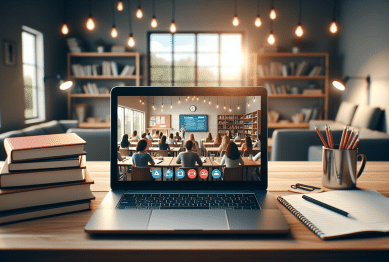Distance learning continues to reshape education and society, making flexible study options more accessible than ever. Explore how diverse learners, innovative institutions, and creative educators are finding academic and personal growth in the evolving landscape of digital education.
Understanding the Foundations of Distance Learning
Distance learning has become a transformative force in modern education, giving learners around the world expanded access to digital classrooms, online credential programs, and virtual teacher encounters. At its core, distance learning empowers students who may not thrive within traditional educational structures, offering flexibility and self-paced options that adjust to varying schedules. Many groundbreaking distance education initiatives use real-time online platforms and asynchronous content delivery, helping ensure everyone has the opportunity to participate fully, regardless of background or geographic location. The rise of digital courseware, interactive learning modules, and collaborative technologies makes this a vibrant, thriving sector within education and society.
Educational equity has become a recurring theme, as distance learning can help close gaps for underserved communities and non-traditional students. Schools and universities are increasingly using accessible resources and open educational materials to foster inclusive environments. Key to this evolution is the commitment of instructors to personalized feedback and adaptive curriculum strategies, making content more meaningful for all learners. With rapid advancements in technology, virtual schools and online universities can now deliver robust curricula and dynamic peer interaction, challenging previously held notions about classroom limitations.
An important aspect of distance learning is its adaptability. Whether students are pursuing professional development, changing careers, or seeking foundational qualifications, remote education provides pathways designed to meet individual goals. Many institutions now offer blended models, combining the best facets of in-person and digital experiences. This trend toward layering traditional with digital is forging new concepts of lifelong learning, enabling people to keep up with swiftly changing job markets and societal needs. The evolution of distance learning is ongoing—every semester brings fresh innovations and participant success stories.
How Institutions Are Designing Successful Digital Programs
Schools, colleges, and certification bodies worldwide are dedicating resources to refine online program design. The main goals? Enhance learner engagement, support diverse needs, and maintain rigorous standards for online degrees and certifications. Platforms now frequently incorporate live-streamed lectures, discussion forums, and social networking for group projects, simulating the social learning of traditional classrooms. Distance education models also leverage sophisticated assessment tools and learning analytics, tracking progress to inform tailored support and instructional improvements.
Collaboration is key in the evolution of remote academics. Many programs foster partnerships with industry, government, and non-profit organizations, connecting coursework to real-world challenges. This applied approach resonates with students seeking relevant digital skills for emerging markets. In addition, many credentialing organizations have set standards for digital courses, ensuring graduates gain recognized, transferable qualifications. Accessibility features—such as captioning, language supports, and screen-reader compatibility—are now standard, enabling learners of all abilities to participate without barriers.
Innovative design strategies don’t just focus on digital tools—they include training for faculty. Universities frequently offer professional development in online instruction, helping educators create engaging learning environments. Peer review is increasingly common, maintaining course quality and driving ongoing program improvements. These multi-layered approaches have led to wide-ranging success stories, such as graduates gaining employment in their fields or professionals using distance learning for career advancement. As educational technologies improve, even more learners can benefit from accessible, relevant, and rigorous online programs.
Real-Life Impact: Distance Learners Share Stories
The true measure of any educational system lies in the experiences of its participants. Many distance learners have tackled barriers ranging from crowded schedules to remote locations or limited mobility. With online education, people from rural communities, employed adults, caregivers, and aspiring professionals alike describe how remote learning opened doors. Some recount improved work-life balance, as flexible study hours fit around personal demands. Others appreciate the chance to engage with global peers in collaborative projects.
Graduates often share powerful reflections on the sense of accomplishment and autonomy distance education has fostered. Many cite the importance of self-discipline, as remote courses place heightened responsibility on learners to organize their time and set goals. Online forums, virtual group work, and accessible instructor feedback are frequently mentioned as pillars supporting student motivation. For some, digital programs provided a safe space to revisit education later in life—without the pressure or social barriers sometimes present in on-campus environments.
Distance learning success stories highlight more than just academic achievement—they reflect personal growth. Participants frequently report gains in resilience, digital literacy, and problem-solving. Many describe newfound confidence to tackle advanced studies or pursue leadership positions in their fields. As more people experience these transformations, their stories ripple through communities, inspiring others and helping to shift broader perceptions about online study’s value and societal impact.
Emerging Trends and Challenges in Remote Learning
The distance education landscape is constantly evolving. One notable trend is a surge in micro-credentials and stackable program options, enabling students to build qualifications at their own pace. These flexible formats appeal to working adults and those seeking targeted knowledge for career shifts. Equity in access remains a key concern, with digital divide issues—such as broadband availability—still presenting obstacles. Many public and private sectors are tackling this by investing in infrastructure and affordable device programs to broaden access.
Student engagement and well-being also pose ongoing challenges. While digital classrooms foster autonomy, sustained motivation can be difficult for some students. Institutions are responding by developing peer mentoring, virtual office hours, and mental health support networks tailored for distance learners. Instructors continually experiment with multimedia, gamification, and adaptive learning modules to create more interactive and stimulating experiences. Feedback loops—soliciting input from learners—play an essential role in keeping platforms responsive and relevant.
Assessment methods are transforming, too. Traditional exams are often replaced by project-based tasks, portfolios, and frequent low-stakes quizzes, better reflecting 21st-century skill requirements. Academic integrity remains a priority, prompting the use of advanced proctoring software and honor code adoption. As policies, tools, and learner support adapt, remote education continues to broaden possibilities, offering durable solutions to a rapidly shifting educational and economic landscape.
How to Make the Most of Your Digital Learning Experience
For those exploring or enrolled in distance education, establishing strong study habits is crucial. Setting clear goals, maintaining a dedicated workspace, and following a realistic schedule can provide structure and direction. Many successful online students recommend periodic check-ins—both with themselves and peers—to track progress and recalibrate strategies. Taking advantage of available tools, such as time management apps or collaborative platforms, can streamline learning and enhance performance.
Active participation in virtual classrooms can deepen engagement. This might mean joining peer discussion boards, asking questions during webinars, or seeking feedback from instructors. Cultivating connections with fellow students encourages accountability and makes the remote experience less isolating. Many platforms now host breakout groups and extracurricular communities to strengthen social bonds and foster wider networking opportunities for learners.
Well-being should remain a priority throughout the digital education journey. Taking regular breaks, balancing screen time, and practicing mindfulness can help prevent burnout. Learners should not hesitate to access mental health resources or student support services offered by their institutions. Every student’s path is unique, but embracing these proactive strategies can help ensure a positive distance learning journey and lead to genuine, lasting growth both academically and personally.
The Future of Distance Learning in Society
Looking ahead, distance education is poised to remain a leading force in broadening access to knowledge and skill acquisition. As more societies embrace lifelong learning, digital models will become even more integrated into daily life and career development. Hybrid models combining classroom and online experiences are expected to expand further, offering learners greater choice and flexibility. Innovations such as artificial intelligence, immersive virtual reality, and adaptive assessments promise an even richer and more tailored educational landscape.
Societal acceptance of online credentials is increasing, with employers recognizing the depth and rigor of accredited digital programs. Many fields now specifically value digital literacy, remote teamwork, and self-motivation—skills honed through distance learning platforms. This acceptance is helping to reduce stigma associated with non-traditional education pathways and encourages people from all backgrounds to pursue new opportunities.
Ultimately, distance learning reflects broader shifts in how society values continuous improvement and personal development. As access expands and technology continues to improve, the number of success stories grows. Each story paves a way for others, reinforcing distance education’s pivotal role in supporting resilient, adaptable communities ready to thrive in a rapidly changing world.
References
1. UNESCO. (n.d.). Distance learning solutions. Retrieved from https://en.unesco.org/covid19/educationresponse/solutions
2. EDUCAUSE. (2022). 7 Things You Should Know About the HyFlex Course Model. Retrieved from https://library.educause.edu/resources/2020/7/7-things-you-should-know-about-the-hyflex-course-model
3. U.S. Department of Education, Office of Educational Technology. (n.d.). Reimagining the Role of Technology in Education. Retrieved from https://tech.ed.gov/files/2017/01/NETP17.pdf
4. National Center for Education Statistics. (2021). Distance Learning. Retrieved from https://nces.ed.gov/fastfacts/display.asp?id=80
5. The Chronicle of Higher Education. (2022). Online Learning Grows Up: A Review of the Latest Research. Retrieved from https://www.chronicle.com/specialreport/Online-Learning-Grows-Up/314
6. International Society for Technology in Education. (2023). Standards for Online and Blended Learning. Retrieved from https://www.iste.org/standards/for-educators









